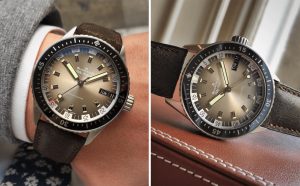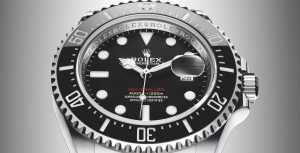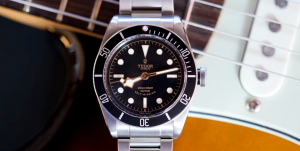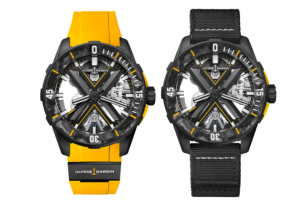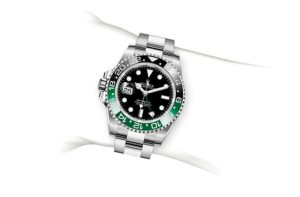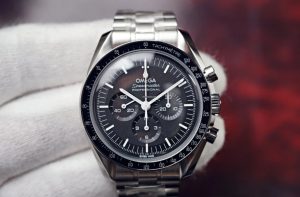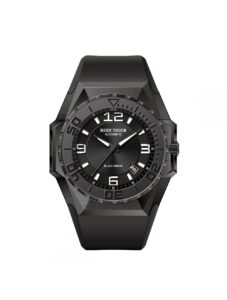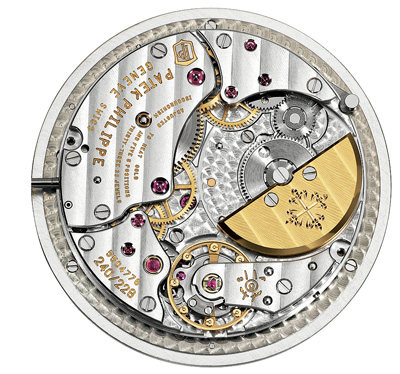
The micro-rotor serves to rewind automatic movements, but stands out from traditional rotors in terms of its size, it shape and its position. The customary oscillating weight is a flat half-disk topping the movement. The micro-rotor is a small, thick half-disk fully integrated into the movement. It was invented almost concomitantly in 1957 by Buren and Piaget, and subsequently popularized by Universal Genève, which had patented its own in 1954. It represented a quest for technical performance, and of course for greater slimness. These two objectives have remained in place and are now even more strongly present. Of the three original firms involved, only Piaget continued using the micro-rotor, which proved a determining factor in the second race for horological slenderness undertaken in the 2000s. One should also mention a fourth actor that came to play an indispensable role in the field : Patek Philippe. In 1997, in the midst of the quartz crisis, the brand developed an ultra-thin self-winding movement, named Caliber 240 in accordance with its thickness. To achieve this, the brand had recruited the creator of the Universal caliber, thereby vividly proving the importance of experience in conceiving these distinctive movements.

Calibre 240 © Patek Philippe
New lease on life
In the 2000s, the pursuit of perfection and diversification was an integral part of the grand watchmaking revival. To stand out from the crowd, several brands opted for the micro-rotor despite its inherent disadvantages. Given its lower inertia than a large-size rotor, it winds barrels less efficiently. By way of example, the newly introduced Montblanc micro-rotor requires 11 hours on a Cyclotest machine stimulating daily wear to be fully wound, as against eight hours for a standard automatic model. To compensate for this fact, the micro-rotor is made from extremely heavy materials : tungsten in cheaper versions, and 22K gold or even platinum for prestigious interpretations. It thereby achieves standard and even comfortable power reserves. Such is the case of several Roger Dubuis movements, of the Vaucher Caliber 5401 used by Hermès, Richard Mille and Parmigiani, and also of Caliber 1.98 by Chopard, which has a 65-hour power reserve.
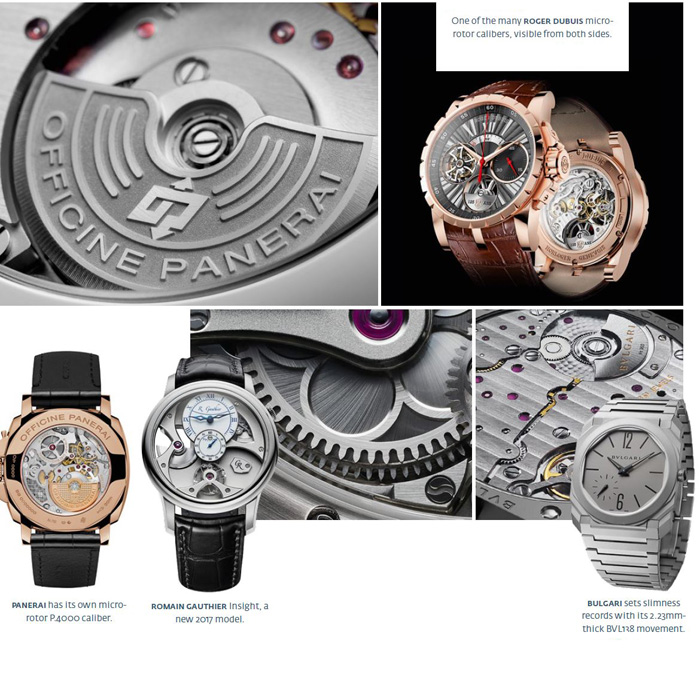
Expansion
In 2002, Girard-Perregaux had developed a variation of its Tourbillon with Three Gold Bridges featuring a micro-rotor concealed beneath the barrel, which meant it went almost unnoticed. Based on the Peseux 7001 caliber, MCT has created its own movement that it still uses to this day. Then came the turn of Laurent Ferrier. This technically elegant and distinctive solution is still in vogue, since no less than three brands have opted for this solution in 2017 : Romain Gauthier, Peter Speake-Marin and Bell&Ross (via its movement producer MHC). But the big names are still in search of the most favorable technology/ergonomics/slenderness ratio for the micro-rotor. Panerai and Bulgari have adopted this solution and their technical choices are representative of the current trend. The micro-rotor is definitely more efficient when it is heavy, and even more so if it is broad, meaning as part of wide movements. Calibers have definitely grown, from Patek Philippe’s 240 movement measuring 27.5mm to the 36.6mm BVL138 by Bulgari. The concept is also becoming increasingly flexible and adaptable to movements ranging from the simplest to the most elaborate, as showcased in the Grande Complication de Cartier.
Eventually, the motion. These brand new steel versions of this Parmigiani Fleurier Tonda 1950 come with all the calibre PF702. The form of the bridges, the engraving on the micro-rotor, the placement of the technical components, the variable-inertia equilibrium wheel or the ending of the parts seem the same to me. Still, Parmigiani announces that the PF702 motion of the steel versions have 48h of power book (vs. 42h for the gold versions). It means an upgrade of the mainspring or less energy consumption. And that’s again great news. For the remainder, the movement is a pleasure for the eyes, together with hand-finishings around — polished chamfers, circular graining on the primary plate, Geneva stripes, glistening sinks and screws… Undoubtedly pleasant.Now comes the final hammer stroke… The price of these Steel Parmigiani Fleurier Tonda 1950. Well, you will be able to receive them (white or black) for 8,950 Euros (retail price). With a movement of the pedigree, it is a bargain, think us.To kick off the new year, Parmigiani Fleurier declared two new timepieces using their unique “Galaxy” method of texturizing dials. The Parmigiani Fleurier Tonda 1950 Galaxy Gold Bracelet and the Tonda Métropolitaine Selene would be the newest unofficial (possibly official at some stage) “his and hers” dress watch offerings out of the brand.
The Ovale XL instance is another upside to the watch (as I said above). Dimensions are 37.6mm wide by 44.8mm tall and 12.2mm thick. It wears somewhat larger than it sounds, given the broad lugs, also in 18k rose gold it seems absolutely lovely. I want to use the phrase “elegance” again to describe my view of how it looks. To me this implies it has the graceful curves of a natural form, while also being aesthetically pleasing to the eye using a cohesive type. It is essentially a dress watch that gets extra attention since it is distinct, but in no manner lost or of questionable taste. The simple fact that it’s a fancy tourbillon is that the expensive icing on the cake.As far as I can consider, Parmigiani knows the Ovale XL situation is unique, and doesn’t use it for anything under $50,000 USD. That is a shame because I’d like for there to be a steel or ceramic version using a simple automatic movement (still from the tonneau-shape) that is priced considerably less. It would serve as a marginally more avant-garde counterpart to the Parmigiani Tonda 1950. Maybe Parmigiani will amuse this petition in the future.Like many Parmigiani watches, the Ovale XL Tourbillon comes fitted with an Hermès strap, this time in indigo blue alligator. I locate the relative width of the strap (thanks to this broad lugs) to be a flattering look, and it also helps enrich the formal, yet manly position of this timepiece’s overall form. A 30 next tourbillon will spin faster (clearly) than the usual 60 second tourbillon, and consequently its actual purpose is to offer an improved sense of visual cartoon on the dial. A graceful rose gold line frames the open tourbillon window and bridge being a detail I very much appreciate.
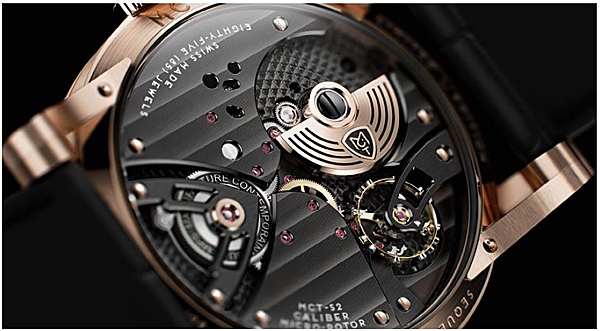
Calibre S2 de MCT © MCT
It’s little details such as this which make Parmigiani timepieces appeal to the type of person ready to invest $200,000 on a luxury watch. Is it the blingiest or trendiest luxury watch on the market? Cost for your Parmigiani Ovale XL Tourbillon benchmark PFH750-1000600-HA3141 watch is $195,000 USD.Here is an interesting watch that will no doubt be tremendously appealing to a very niche group of watch fans. It is not that the Parmigiani Emploi Tonda 1950 product itself is a niche-appeal item (quite the contrary actually), but instead this meteorite snowflake edition of this will be one of the rarer and arguably more exotic variants. More often than not, exotic is used to describe a dial versus an entire watch. In fact, very few truly exotic (from a entire design perspective) vintage watches are really that popular (many are laughed at — and perhaps justifiably so). Is it really true that most classic watches look exactly the same and are highly conservative in fashion? Of course not. Folks strangely fetishize a number of the very ordinary, pedestrian designs when it comes to a great number of classic timepieces. What often separates a more “interesting” out of “classic” watch are mere colors alone. It is, therefore, the fact that many “exotic” watches in the classic sense are otherwise ordinary or well-received watches with different dials or colors. This is about as exotic as many of the conservative collectors seem to get (as much as I see it). I occasionally wish I watched more “bravery” in watch tastes. Though, I do respect not needing to be brave considering today’s costs.
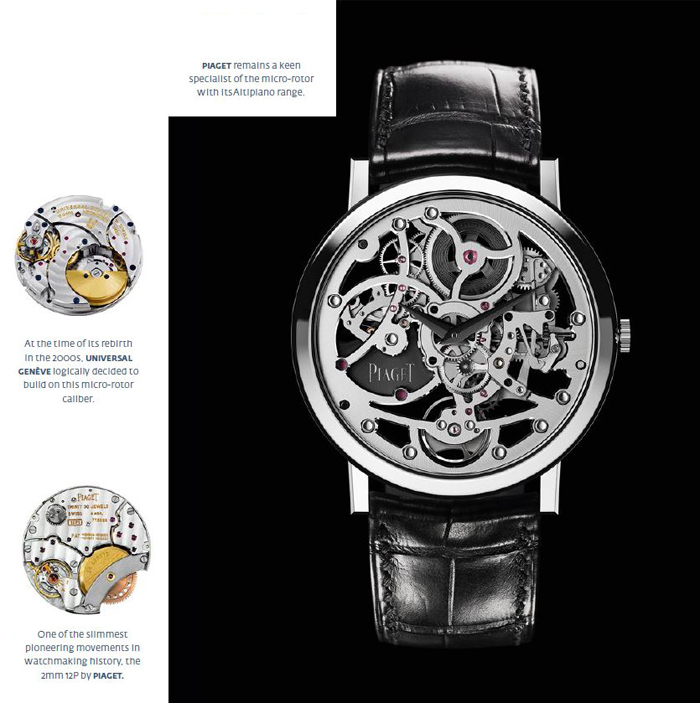
Paul’s position
The micro-rotor is a great way of saving height in a movement for an ultra-thin watch or for freeing up space to show off a wonderful open-worked movement. But as I discovered earlier this year while researching an article for WorldTempus, micro-rotor movements do not come cheap. Only a handful of brands offer micro-rotor watches below 10,000 Swiss francs, making them a watch for the connoisseur. – Paul O’Neil, WorldTempus editor-in-chief
